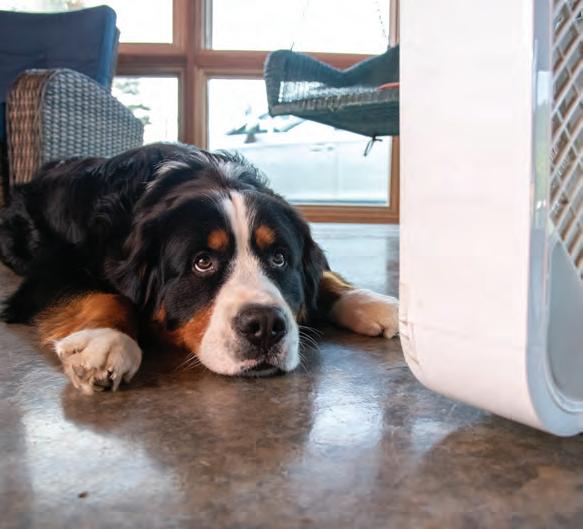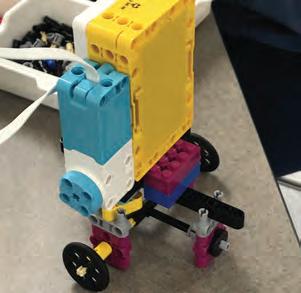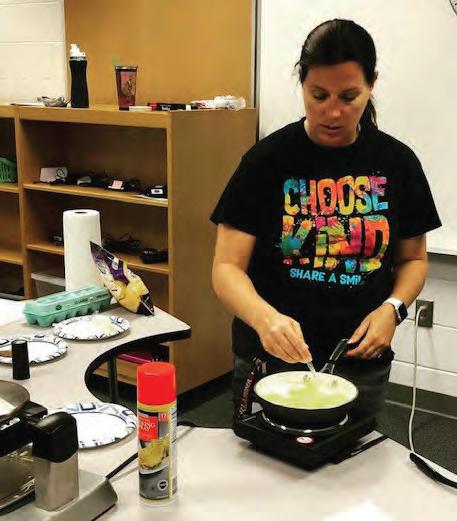
10 minute read
Energy Sense
from 2022-08-CCEC
Ready, Set, (Your) Thermostat!
The right settings can help save energy
By Miranda Boutelle
Heating and cooling account for about half the energy used in a typical home, so it’s a great place to use less energy. When used wisely, your thermostat can help reduce wasted energy.
Here’s some information on thermostat types, common operational misconceptions and best practices you can start today.
Types of thermostats Mechanical thermostats are easy to control by adjusting a dial or sliding a switch. The downfall is you must make temperature adjustments manually, which is easy to forget. They are inefficient because they typically heat or cool the home beyond the set point.
If your cooling is set to 72 degrees, a mechanical thermostat may actually cool your home to 70 degrees before it turns off, wasting energy. Then it might not come on again until the home reaches 74 degrees. That four-degree temperature change is noticeable and can lead people to adjust the thermostat setting down even more, which wastes more energy.
Also, some mechanical thermostats contain mercury. You can determine that by removing the front plate and looking for small glass bulbs. If your thermostat contains mercury, replace it and find a way to properly recycle it.
Digital thermostats are more accurate, efficient and some are programmable, which is a great option for people who don’t have reliable broadband access.
Smart thermostats, which require an internet connection, are Wi-Fi-enabled and can be controlled using a smartphone app. Programming is easier, and you can track and manage use and temperature data.
Smart thermostats can learn your preferences and set a schedule that automatically adjusts the temperature. Some have geofencing, which adjusts the temperature based on the distance your smartphone is from home.
Misconceptions about thermostats A common misconception is the higher you turn your thermostat up or down, the faster your home’s temperature will change. Turning your thermostat down to 55 degrees to cool your home faster is like repeatedly pushing the elevator button and expecting it to come faster.
It’s likely you will forget you adjusted it, and waste energy by over heating or cooling the home. Set your desired temperature for heating and cooling, or program your thermostat so you don’t make extreme adjustments.
Many people believe it takes more energy to heat or cool a house instead of leaving it the same temperature. The larger the temperature variance between inside and outside, the more energy your system uses. Setting your thermostat 7 to 10 degrees from its normal setting for eight hours a day can save up to 10% a year on your energy bill, according to the U.S. Department of Energy (DOE).
Best practices Use these cooling tips from the DOE to add efficiency and savings to your home:
■ Set your thermostat to 78 degrees in the summer when you are home and awake, and warmer at night or when away. ■ Upgrade to a programmable or smart thermostat that automatically adjusts the temperature throughout the day and when you leave the house. ■ When on vacation, set your thermostat to 85 degrees in the summer.
■ In the summer, fans allow you to set your thermostat about 4 degrees warmer without feeling it. Remember, fans cool people not rooms, so turn them off when you leave a room.
■ Use your thermostat to optimize energy efficiency and find a balance between comfort and affordability.

This column was written by Miranda Boutelle of the Efficiency Services Group. Visit carolinacountry.com/your-energy for more ideas on energy efficiency.
Unlimited Talk & Text only $1999/mo.*
Our easiest Jitterbug® phone ever.
The Jitterbug® Flip2, from the makers of the original easy-to-use cell phone, has big buttons and an exclusive Urgent Response button on the keypad. EASY TO USE Today, cell phones are hard to hear, difficult to dial and overloaded with features you may never use. That’s not the case with the Jitterbug Flip2. A large screen, big buttons and one-touch speed dialing make it easy to call family and friends. The powerful speaker ensures every conversation will be loud and clear. A straightforward list-based menu makes navigating the phone simple. EASY TO ENJOY Wherever you go, a built-in camera makes it easy and fun for you to capture and share your favorite memories. And a built-in reading magnifier and LED flashlight help you see in dimly lit areas. With all the features you need, the Jitterbug Flip2 also comes with a long-lasting battery, so you won’t have to worry about running out of power. EASY TO BE PREPARED Life has a way of being unpredictable, but you can be prepared in an uncertain or unsafe situation with Urgent Response Service. Simply press the Urgent Response button to be connected with a highly trained Urgent Response Agent who will confirm your location, evaluate your situation and get you the help you need, 24/7. The Jitterbug Flip2 is one of the most affordable cell phones on the market and comes with reliable nationwide coverage. With no long-term contracts or cancellation fees, you can switch plans anytime.
Flexible and a ordable plans
$1499/mo. * 300 minutes 10¢ per text
$1999/mo. *
Unlimited minutes Unlimited texts To order or learn more, call 1.866.668.0054
Most reliable nationwide coverage No long-term contracts Keep your current phone number 100% U.S.-based live customer service No hidden monthly fees
Available in-store or online at: lively.com/flip
*Monthly fees do not include government taxes or fees and are subject to change. Plans and services may require purchase of Lively device and one-time setup fee of $35. Urgent Response or 911 calls can be made only when cellular service is available. Urgent Response tracks an approx. location of device when device is turned on and connected to the network. Lively does not guarantee an exact location. Urgent Response is only available with the purchase of a Lively Health & Safety Package. Consistently rated the most reliable network and best overall network performance in the country by IHS Markit’s RootScore Reports. By enabling Alexa on the Jitterbug Flip2, you acknowledge that Lively is not responsible for Amazon Alexa’s functionality or services. Amazon, Alexa and all related logos are trademarks of Amazon.com, Inc. or its a liates. Screen images simulated. Appearance of device may vary. LIVELY and JITTERBUG are trademarks of Best Buy and its a liated companies. ©2022 Best Buy. All rights reserved.
Bright Ideas

in Action
Education grants spark innovation in NC classrooms
By Sarah Thompson

For nearly 30 years, the North Carolina’s electric cooperatives have given more than 600 annual grants to support teachers creating innovative ways for students to learn through the Bright Ideas program. Since 1994, co-ops have issued more than $14.3 million in grants that have benefited well over 2.8 million students. Teachers can apply for grants every year to fund experiential projects and new classroom resources. Here are a few of this year’s projects, inspiring students across the state.

Sarah Thompson is the 2022 editorial intern for
Carolina Country. Rutherford EMC Teacher: Danna Ritchie, Catawba Heights Elementary School
Participating Students: 50
LEGO is more than a toy. Through Bright Ideas, students were given LEGO bricks to build race cars and compete against their peers as an example of force and motion. This project made the second graders excited to learn and gave the teacher a new resource to use with her future students.
Roanoke Electric Cooperative Teacher: Roger Brown, Bertie Middle School
Participating Students: 450
Through this project, students learned how to play the drums and apply their skills and understanding of rhythm to their own music. The project exposed students to a variety of cultural genres of music such as Cuban, African, Poco and Latin. The students performed a drum circle influenced by these genres, and capped off the project with a 30-minute concert in front of their peers and community.
Lumbee River EMC Teacher: Sylvia Beckham, Seventy-First Classical Middle School
Participating Students: 170
It’s difficult to teach students how to engineer, invent and innovate without the right materials. Middle school STEM Innovators are assured a wide variety of STEM projects and resources to let their imagination run wild. Some of the projects of this year’s STEM Innovators included solar powered cars, rocket building, 3D printing and coding LEGO robots. Next year, teacher Sylvia Beckham plans on teaching seventh graders how to build and fly drones. These projects are possible because of the classroom training kits made available by the support of Lumbee River EMC.

Tri-County EMC Teacher: Rebecca Richards, Grantham Elementary
Participating Students: 300

Through teacher Rebecca Richards’ project, students learned how to program, code and engineer using supplies provided by Sphero Mini Education, as well as the help of local businesses in the industry. These resources allowed students to practice problem-solving strategies and challenged them to hone real world skills. “Time to Cook”


Albemarle EMC Teacher: Jennifer Robinson, Moyock Middle School
Participating Students: 200
Through this project, students learned the basics of cooking from budgeting for food, planning meals, reading recipes and, of course, how to create delicious meals. In class, the students made cinnamon sugar biscuits, cinnamon roll waffles and grilled cheese sandwiches with tomato and bacon. The hope of this project is to encourage students to explore foods and gain confidence in the kitchen.
Haywood EMC Teacher: Sam Yancey, Haywood County Schools
Participating Students: 200
Through this initiative, students from second through fifth grade learned how to upcycle household and classroom materials using Strawbees-brand sustainability stations. This project helped students become experts in finding alternative uses for plastic materials. They were given the freedom to tinker, create and combine recycled materials to produce sustainable and innovative objects. Teacher Sam Yancey hopes this experience will shape the newest inventors that will remake the world into a better place by creating something new with something old.

Saddle Up and Read

Caitlin Gooch is an equestrian encouraging children to achieve literary excellence
By Rue Reynold
Caitlin Gooch
Claim to fame: Caitlin started riding horses at age 3 and has leveraged her love of animals as a way to promote literacy. Where you’ll find her: Keep an eye on Saddle Up and Read’s Facebook (facebook.com/saddleupandread) and Instagram (instagram.com/saddleupandread) pages to keep up to date on events in your area.
Wendell native Caitlin Gooch began life with a love for animals and helping others. She became invested in her community at an early age, and while volunteering at the Boys and Girls Club, Caitlin discovered literary deficiency cases in children growing at an alarming rate.
Having only a few horses and nothing else, Caitlin took the reins and worked from the ground up to make a change. That passion created Saddle Up and Read (saddleupandread.org), a nonprofit that blends education, inspiration and interaction all in one to increase literacy in children with the assistance of horses.
All of Saddle Up and Read’s programs are free to attend and enjoy. Farm Reading Sessions can help instill personal growth, responsibility and confidence as children read and interact with horses.
The Literary Outreach program involves children checking out at least three books from a partnering library to be entered into a random drawing. Winners are given a certificate to visit Caitlin’s farm to enjoy the full Farm Reading experience.
Caitlin also travels to parks and neighborhoods with books and her partner, Man-Man the miniature horse. As children interact with Man-Man, Caitlin excites their interest in reading with flash cards and a reading session.
“I want people to know this is something they can do,” Caitlin says. “They can do whatever it is they feel their heart is telling them to do, whether it’s to change the world or change themselves.”
Rue Reynold is the editorial assistant for Carolina Country.







